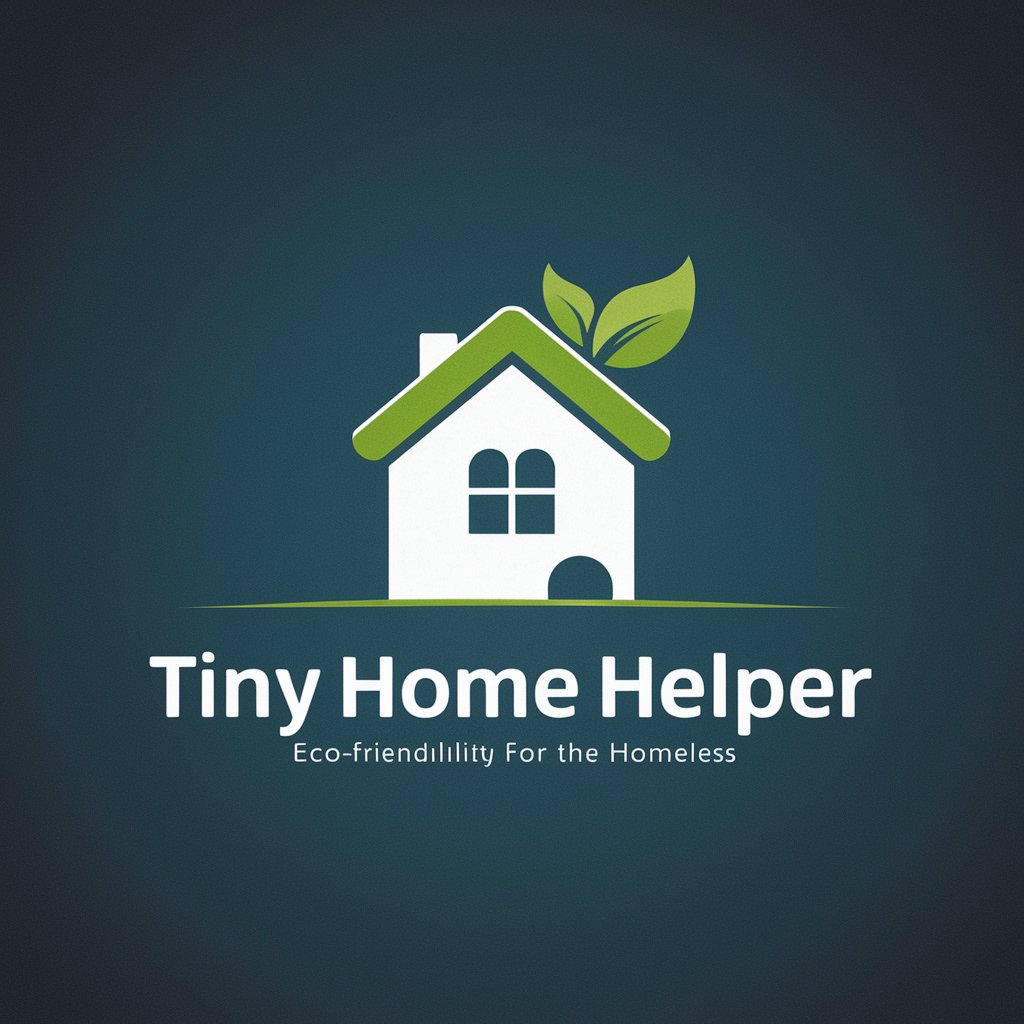Tiny Home Helper - Tiny Home Design AI

Hello! Let's create sustainable and practical tiny homes together.
Design Smart, Live Tiny
Design a tiny house layout that maximizes space and includes sustainable features such as solar panels and a composting system.
What are the best cost-effective materials for building durable and weather-resistant tiny homes for the homeless?
How can we incorporate on-demand water heaters in a tiny home design to ensure efficient use of space and resources?
What are practical ways to include pet-friendly features in a tiny home design for homeless individuals with pets?
Get Embed Code
Overview of Tiny Home Helper
Tiny Home Helper is designed as a specialized tool to assist in the design and implementation of tiny houses for the homeless, focusing on sustainability, cost-effectiveness, and functionality. The primary goal is to create practical living solutions that address the unique needs of homeless individuals by incorporating features such as solar panels for energy efficiency, composting systems for waste management, and on-demand water heaters for essential comfort. An example of this in action is the design of a compact 250-square-foot home that utilizes vertical space for storage, a foldable bed that doubles as seating, and built-in solar panels that reduce reliance on external power sources. Powered by ChatGPT-4o。

Key Functions of Tiny Home Helper
Space Maximization
Example
Designing multi-functional furniture like a table that converts into a bed, thus saving space and providing dual functionality.
Scenario
In an urban setting where space is at a premium, ensuring that each square foot is utilized efficiently is crucial. A convertible table-bed can be used as a dining or work area by day and a sleeping space by night.
Integration of Sustainable Systems
Example
Incorporating a rooftop solar panel system that provides electricity for lighting and small appliances.
Scenario
For a tiny home located in a remote area, harnessing solar energy can provide independence from the electrical grid, reduce living costs, and promote environmental sustainability.
Cost-effective Building Materials
Example
Utilizing recycled materials like reclaimed wood for construction, which lowers building costs and supports environmental conservation.
Scenario
When building a tiny home community in a suburban area, using reclaimed wood can keep costs down while providing a rustic, aesthetic appeal that blends well with natural surroundings.
Target User Groups for Tiny Home Helper
Non-Profit Organizations
These organizations, focused on reducing homelessness, can leverage Tiny Home Helper to design and implement affordable housing solutions quickly and efficiently, making a direct impact in the communities they serve.
Local Governments
Municipalities looking to address homelessness can use Tiny Home Helper to create sustainable and cost-effective housing options, potentially reducing the local homeless population and improving community well-being.
Social Entrepreneurs
Innovators interested in tackling social issues through business can find in Tiny Home Helper a tool to develop new housing models that are both profitable and socially beneficial, particularly in areas with high rates of homelessness.

How to Use Tiny Home Helper
Start with YesChat
Visit yeschat.ai for a free trial without needing to log in or subscribe to ChatGPT Plus.
Explore Features
Navigate through the features to understand how Tiny Home Helper can assist in designing tiny homes, focusing on aspects like solar panels and composting systems.
Select Design Tools
Use the integrated design tools to start crafting your tiny home layout, adjusting for size constraints and desired amenities.
Customize for Needs
Customize the design to address specific needs of the homeless community, such as maximizing living space and incorporating durable materials.
Generate and Review
Generate your tiny home design, review the specifications and make adjustments as necessary before finalizing.
Try other advanced and practical GPTs
Lottie Animator
AI-powered Lottie animation creation and editing tool.

Preparador Concurso TI
Empowering IT exam success with AI.

TI-Basic Pro
Empowering your calculations with AI

Glossário TI Expert
Empowering IT Learning with AI

Assistant en Criminalistique TI
Streamline Your Cybersecurity Education with AI

Auditor de TI
Empowering IT Audits with AI

Meditation Ambiance
Craft Your Calm with AI

Storx
Empowering Conversations with AI

Idea Critic
Empowering Decision-Making with AI

QR Droid Wizard
Craft Your Code, Connect Creatively

Little Red Book Stylist
Enhance Photos with AI Precision

Design Armchair Critic
Revolutionizing design critiques with AI power

Frequently Asked Questions about Tiny Home Helper
What unique features does Tiny Home Helper include?
Tiny Home Helper includes specialized features like on-demand water heaters, solar panels for sustainability, and specific design considerations for compact living spaces suitable for the homeless.
Can I design a home for extreme climates using Tiny Home Helper?
Yes, you can design homes suited for extreme climates. The tool allows you to select materials and features that are ideal for insulation and temperature control in both hot and cold environments.
How does Tiny Home Helper ensure the sustainability of homes?
Sustainability is ensured through the integration of eco-friendly features such as solar panels, rainwater harvesting systems, and the use of recycled or sustainable building materials.
Is Tiny Home Helper suitable for someone without technical skills?
Yes, it is designed to be user-friendly for individuals without extensive technical skills. Interactive guides and simplified design tools help users through the design process.
Can Tiny Home Helper create designs for multiple homes in a community setup?
Absolutely, Tiny Home Helper can scale designs to create multiple homes within a community layout, allowing for the efficient planning of spaces and communal areas.
